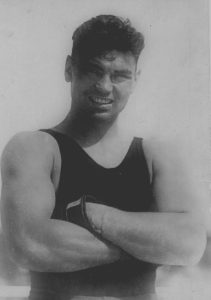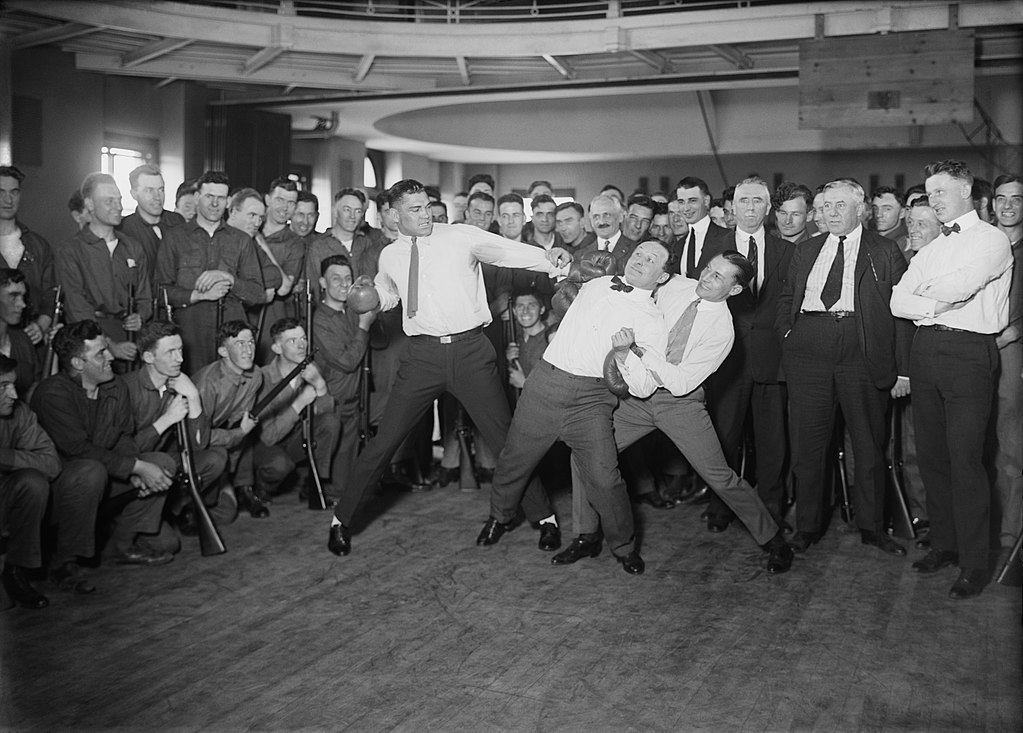Jack Dempsey, known as “The Manassa Mauler,” stands tall in boxing history. But what set him apart from other greats? Was it pure talent, tough upbringing, or sheer determination?
Jack Dempsey was renowned for his exceptional combination of speed, power, and aggression. His unique bob-and-weave style made him a challenging target, while his ferocious punches often ended matches decisively. Rooted in a tough upbringing, his hunger for success and determination made him a standout figure in boxing history.
Join me as we dive deep into the life and career of Dempsey, uncover the reasons that made him a boxing legend.
Early Life and Background
Born as William Harrison Dempsey in Manassa, Colorado, Jack Dempsey’s life was emblematic of an era where hardship was often the crucible from which great fighters were forged. Being one of 11 children in a family that constantly grappled with financial insecurity, he experienced deprivation from an early age.
The family’s frequent relocations due to his father’s difficulty in securing stable employment made Dempsey’s early life tumultuous. He had to forsake his elementary education, choosing instead to work in order to support his family.
At the tender age of 16, a restless and determined Dempsey left home. He journeyed through the west, riding on freight trains alongside hobos. These travels exposed him to the raw and often brutal realities of life, especially in the mining towns where he occasionally settled. It was during these years that Dempsey developed his fighting prowess, not for sport, but as a stark necessity for survival.

In a world where money was scant and hunger was a constant companion, Dempsey found an unorthodox way to earn a living. He would walk into saloons, boldly proclaiming, “I can’t sing and I can’t dance, but I can lick any SOB in the house.”
These audacious challenges rarely went unanswered, with barroom bets being placed on the outcome. As Dempsey noted in his autobiography, he rarely experienced defeat in these spontaneous brawls.
Reflecting on those times in a 1956 interview with “The Ring Magazine,” Dempsey observed, “Nobody has to go hungry today. There is plenty of work for a man who wants to work. A kid can make plenty of dough for himself doing almost anything. I was hungry. I had to fight my way along. Freights and the like, fight, fight all the time. The life was tough, but it hardened you.”
His narrative underscores the contrast between his era and today’s relatively more comfortable times.
Jack Dempsey’s journey from hobo camps to legendary status in boxing isn’t just a testament to his exceptional talent but also an ode to the harsh realities that shaped fighters of his generation.
In a society where the gap between the wealthy and the poor was wide, the hunger and hardships faced by many, including ethnic minorities from ghettos like the Irish, Jewish, and Italians, chiseled tough characters out of ordinary men. They had no scheduled fights or organized programs, but their relentless spirit, often driven by dire circumstances, made them iconic figures in boxing history.
Physical Attributes

Jack Dempsey was not merely a skilled boxer; his exceptional physical qualities also contributed to his success in the ring. At a time when dedicated physical conditioning and specific training regimens were just emerging, Dempsey’s natural physique often set him apart from his peers.
Standing tall at 6 feet 1 inch and weighing in at around 190 pounds during his prime, his frame was certainly imposing. But what made him such a fearsome opponent was his skillful blending of enormous stature with speed and agility.
Dempsey also had unusually large fists, which were often compared to sledgehammers. The sheer impact of his punches, combined with impeccable technique, was overwhelming for many.
However, power wasn’t Dempsey’s only strength. He was widely revered for his granite chin, a testament to his capacity to withstand punishing blows that would have rendered weaker fighters helpless. This resilience allowed Dempsey to confidently engage in brutal toe-to-toe exchanges, knowing full well he could endure and potentially outlast his opponents.
Despite his substantial frame, Dempsey’s agility was a thing to behold. His footwork was nimble, and his hand speed rivalled that of much lighter fighters. This agility enabled him to dodge punches, weave around his opponents, and strike with lightning-quick precision when an opening presented itself.
Jack Dempsey’s Unique Fighting Style
Few boxers in boxing history have garnered as much respect as Jack Dempsey, and much of this can be attributed to his unique and aggressive fighting style. His approach in the ring was a blend of raw power and an unyielding will to dominate. The spectators of his era, accustomed to more restrained and “civilized” boxing bouts, were unprepared for the whirlwind that was Dempsey.
His incredible speed and strength, complemented by more than average boxing skills, made Dempsey a force that few could rival. John Lardner, a prominent American sports writer, once remarked that the phrases “bobbing and weaving” would forever be intertwined with Jack Dempsey.
This was not an exaggeration; Dempsey himself described “the bob” as “a kind of artistic duck” and “the weave” as a rhythmic dance of shoulder rolls. His mastery of this technique allowed him to seamlessly slip under opponents’ attacks, positioning himself to unleash a barrage of devastating punches.
However, it wasn’t just his technique that set him apart. According to Dan Morgan, a seasoned fight manager, Dempsey’s greatness was rooted in three innate qualities: ferocity, cold-bloodedness, and gameness. Where many fighters hesitated to beat a vulnerable opponent, Dempsey showed no such restraint.
He was relentless, a testament to his early life filled with hardships. Hunger, both literal and metaphorical, fueled his drive to win. As Dempsey himself once said, hunger makes a man fight when a richer man would give up.
His early bouts, unlike the more organized fights of his contemporaries like Tunney, Louis, and Marciano, were wild affairs. Dempsey often took whatever fight he could get, even if it meant traveling long hours without rest or food. This rugged upbringing, combined with his ruthless approach, made him a spectacle in the ring.
Dempsey’s movement in the ring was akin to a well-choreographed dance. He would circle his opponents, gauging them, looking for the perfect moment to strike. His footwork was surprisingly good, always in motion, never off balance, making him one of the fastest attackers in boxing history.
When he found an opening, he’d unleash his signature moves – explosive left hooks, right hands, and uppercuts. In his title-winning bout against Willard, he showcased his supreme skill by dodging a jab and responding with a powerful right to the body, followed by a jaw-shattering left hook.
https://youtu.be/WcaDA2xAk8o?si=BsFH_bwro0bk0jZR
Dempsey’s resilience was also legendary. Gene Tunney once noted Dempsey’s incredible ability to recover from heavy punches, calling him “dangerous” even after mere seconds. This resilience, coupled with his unparalleled aggression, set him apart from other fighters.
It was Dempsey’s raw energy and ferocity that led to a change in boxing rules, prompting the need for fighters to retreat to a neutral corner after a knockdown, giving their opponents a fair chance to recover.
His record speaks for itself – out of 84 bouts, he won 62, with 51 of those victories coming from knockouts. The man was a storm in the ring.

